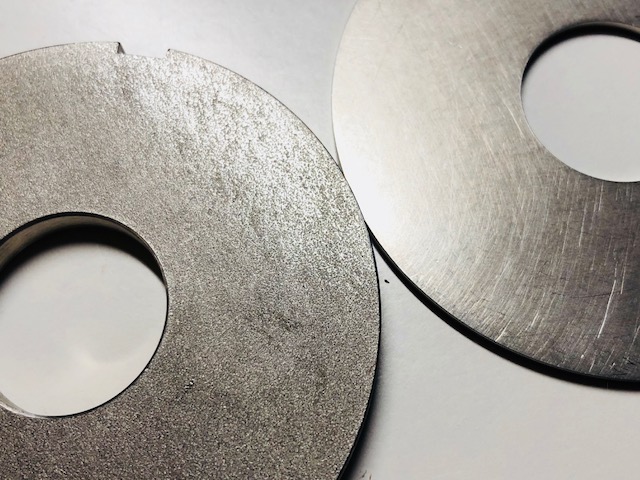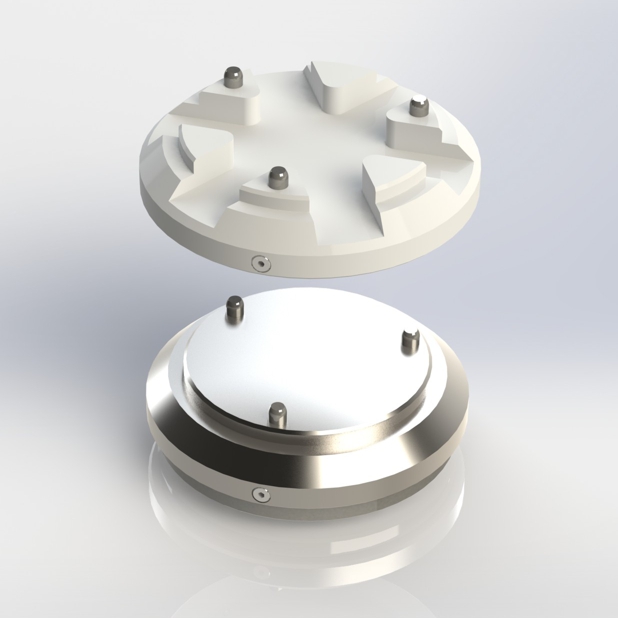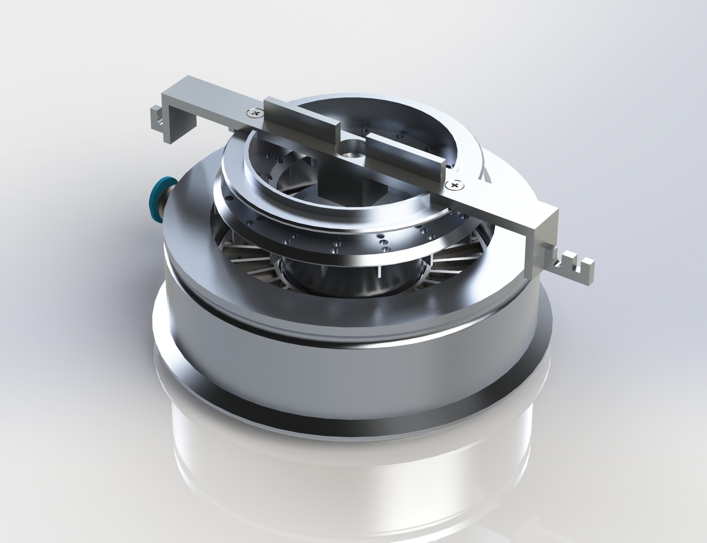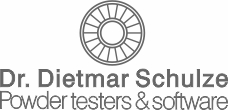Shear cells
 Ring
Shear Testers RST-XS.s are generally delivered with one
shear cell type XS-Mr which is called the "standard shear
cell". For coarser powders a larger shear cell, type XS-Lr,
is available (data see below).
Ring
Shear Testers RST-XS.s are generally delivered with one
shear cell type XS-Mr which is called the "standard shear
cell". For coarser powders a larger shear cell, type XS-Lr,
is available (data see below).
 If
only very limited amounts of powder are available for
testing, shear cell types XS-MV4, XS-Sr or XS-SV3 with
specimen volumes of 3.5 to 10 ml can be used. The table
below gives an overview.
If
only very limited amounts of powder are available for
testing, shear cell types XS-MV4, XS-Sr or XS-SV3 with
specimen volumes of 3.5 to 10 ml can be used. The table
below gives an overview.
| Name |
Description |
| XS-Mr |
"Standard shear cell" with about 30 ml specimen
volume, cross-section about 24 cm²
Maximum particle size depends on the type of powder
and is about 1 mm for broad particle size
distributions and 0.5 mm for narrow particle size
distributions. |
| XS-Lr |
"Large volume": About 70 ml specimen volume,
cross-section about 46 cm²
Applicable for coarser materials than XS-Mr.
Lid provided with vanes similar to XS-Mr.
Maximum particle size depends on the type of powder
and is about 1.5 mm for broad particle size
distributions and 0.75 mm for narrow particle size
distributions. |
| XS-Sr |
"Small volume": About 10 ml specimen
volume, cross-section about 13.5 cm²
Lid provided with vanes similar to XS-Mr.
Maximum particle size depends on the type of powder
and is about 0.5 mm for broad particle size
distributions and 0.25 mm for narrow particle size
distributions. |
| XS‑MV4 |
"Small volume": About 9.5 ml specimen
volume, cross-section about 24 cm²
Lid and bottom rough, no vanes.
Maximum particle size depends on the type of powder
and is about 0.5 mm for broad particle size
distributions and 0.25 mm for narrow particle size
distributions. |
| XS-SV3 |
"Very small volume": About 3.5 ml specimen
volume, cross-section about 13.5 cm²
Lid and bottom rough, no vanes.
Maximum particle size depends on the type of powder
and is about 0.3 mm for broad particle size
distributions and 0.2 mm for narrow particle size
distributions. |
Wall friction cells
 Wall
friction cells are required for the measurement of the wall
friction angle or coefficient of wall friction (friction
between a bulk solid and a wall material). For the test, an
annular wall material specimen ("coupon") is placed in the
shear cell with the bulk solid specimen on top, i.e., the
bulk solid is located above the wall material like on a
hopper wall or a chute, which is absolutely necessary in
order to avoid underestimating the wall friction angle in
the case of segregating bulk solids.
Wall
friction cells are required for the measurement of the wall
friction angle or coefficient of wall friction (friction
between a bulk solid and a wall material). For the test, an
annular wall material specimen ("coupon") is placed in the
shear cell with the bulk solid specimen on top, i.e., the
bulk solid is located above the wall material like on a
hopper wall or a chute, which is absolutely necessary in
order to avoid underestimating the wall friction angle in
the case of segregating bulk solids.
 Wall
material coupons can be made by the customer according to
dimensions given in the tester's manual.
Wall
material coupons can be made by the customer according to
dimensions given in the tester's manual.
| Name |
Description |
| XS-WM |
"Standard" wall friction cell, specimen volume
about 20 ml, outer diameter of the wall material
coupon about 75 mm. |
| XS‑WL0 |
Wall friction cell (low stresses) with specimen
volume of about 30 ml, outer diameter of the
wall material coupon about 88 mm |
Low stress shear cells
 For the Ring
Shear Tester RST-XS.s we offer a shear cell and a wall
friction cell to achieve even lower stresses. Here the shear
lid is attached to the loading rod ("hanging lid"). Fine
resolution of measured stresses is achieved due to the large
cross-sectional area.
For the Ring
Shear Tester RST-XS.s we offer a shear cell and a wall
friction cell to achieve even lower stresses. Here the shear
lid is attached to the loading rod ("hanging lid"). Fine
resolution of measured stresses is achieved due to the large
cross-sectional area.
| Name |
Description |
| XS‑Lr0 |
Dimensions similar to XS-Lr (volume about 70 ml,
cross-section about 46 cm², lid provided with vanes)
|
| XS‑WL0 |
Wall friction cell with specimen volume of about
30 ml, outer diameter of the wall material
coupon about ca. 88 mm |
Compressibility cells
 A
compressibility cell serves to determine the function of
bulk density in terms of stress as accurately as possible.
Due to the flat cylindrical sample space, the influence of
wall friction is minimized.
A
compressibility cell serves to determine the function of
bulk density in terms of stress as accurately as possible.
Due to the flat cylindrical sample space, the influence of
wall friction is minimized.
| Name |
Description |
| XS‑VM |
Compressibility cell (approx. 48 ml specimen
volume, 64 mm specimen diameter). |
| XS‑VS |
Compressibility cell (approx. 20 ml specimen
volume, 48 mm specimen diameter). |
Time consolidation benches
A time consolidation test examines how a bulk solid
consolidates when it is stored at rest (e.g. in a silo or
IBC). To measure this, the bulk solid specimen is first
consolidated with the ring shear tester, then stored under
constant load, and finally sheared to failure. All of this
can be done automatically with the ring shear tester,
without having to remove the shear cell with the bulk solid
specimen from the tester. The disadvantage, however, is that
the tester is blocked by this specimen. Therefore, the use
of a time-consolidation bench for external storage is
recommended.
When using a time consolidation bench, the specimen is
consolidated with the ring shear tester, then removed from
the tester and placed on a time consolidation bench. The
consolidation stress is exerted on the specimen through
weights. After the consolidation period is over (e.g., after
some hours, a day or a week), the specimen is returned to
the ring shear tester and sheared again to measure the
strength of the consolidated powder. Thus, one obtains a
quantitative result on the increase of strength during the
consolidation time, which is known as "caking".
 The
open time consolidation stand (type XS-1O) is used to store
a powder specimen under load. The consolidation stress is
generated by weights and applied to the shear cell via a
vertical rod. The loading mechanism is equipped with a
counterweight, which compensates for the dead weight of the
device.
The
open time consolidation stand (type XS-1O) is used to store
a powder specimen under load. The consolidation stress is
generated by weights and applied to the shear cell via a
vertical rod. The loading mechanism is equipped with a
counterweight, which compensates for the dead weight of the
device.
The design without cover allows contact between the powder
specimen and the ambient atmosphere. This is preferable if
the behavior of the powder in dependence on the ambient
conditions has to be studied, e.g. by storing the time
consolidation bench with the shear cell and the powder
specimen in a climate cabinet.
 The
picture on the right shows the closed version of the time
consolidation stand (type XS-1C). The shear cell, which is
not visible on the image, is located in the cylindrical
protective container, which serves to shield the shear cell
from the ambient atmosphere. Conditioned air or gas can be
blown into the interior of the protective container via a
hose connection.
The
picture on the right shows the closed version of the time
consolidation stand (type XS-1C). The shear cell, which is
not visible on the image, is located in the cylindrical
protective container, which serves to shield the shear cell
from the ambient atmosphere. Conditioned air or gas can be
blown into the interior of the protective container via a
hose connection.
The XS-1C time consolidation stand is based on the XS-1O
open time consolidation stand, which is fitted with a
protective cover. Existing time consolidation stands of type
XS-1O can be converted to type XS-1C by adding the
protective cover.
Shear cell and driving axle for increased temperature
consistency of preheated specimens
 Shear
cell XS-MTL was developed for the examination of samples at
temperatures below or above room temperature. It is
characterized by increased heat capacity (greater intrinsic
mass) and reduced heat transfer to both the tester and the
environment. This means that a powder sample previously
tempered with the shear cell can be examined with the
RST-XS.s (or RST-XS) ring shear tester. The temperature
change is significantly reduced compared to normal shear
cells.
Shear
cell XS-MTL was developed for the examination of samples at
temperatures below or above room temperature. It is
characterized by increased heat capacity (greater intrinsic
mass) and reduced heat transfer to both the tester and the
environment. This means that a powder sample previously
tempered with the shear cell can be examined with the
RST-XS.s (or RST-XS) ring shear tester. The temperature
change is significantly reduced compared to normal shear
cells.
 The
heat
transfer from the shear cell (type XS-MTL or another type)
to the tester can be further reduced if a (retrofittable)
driving axle with exchangeable top part made of PTFE is
used. The small picture (left) shows this driving axle
with top part made of stainless steel and above it the
alternative PTFE top part.
The
heat
transfer from the shear cell (type XS-MTL or another type)
to the tester can be further reduced if a (retrofittable)
driving axle with exchangeable top part made of PTFE is
used. The small picture (left) shows this driving axle
with top part made of stainless steel and above it the
alternative PTFE top part.
In addition, tempered gas can be supplied with a
protective cover (see below), in order to further improve
the temperature constancy of the powder sample.
Gas flow shear cell

With the XS-MA gas flow shear cell, gas can flow
through a specimen during measurement, e.g., to achieve a
defined moisture or gas composition within the powder
specimen. A hose connection is used to supply gas from
below, and the gas can exit through a perforated cover and
the gap between the annular lid and bottom ring.
Protective cover for gas supply
 If
powders have to be tested at a specific atmosphere, e.g., to
prevent change of moisture, or to reduce the risk of
spontaneous combustion, the RST-XS.s can be provided with a
cover around the shear cell (see image). The protective
cover can be supplied with (inert) gas through a hose
fitting for gas supply.
If
powders have to be tested at a specific atmosphere, e.g., to
prevent change of moisture, or to reduce the risk of
spontaneous combustion, the RST-XS.s can be provided with a
cover around the shear cell (see image). The protective
cover can be supplied with (inert) gas through a hose
fitting for gas supply.
The protective cover is provided with openings for tie rod
and push rod for shear force measurement, for the bar of the
horizontal guiding system, and the loading rod of the normal
load system. Since the openings must remain open during
testing, it is necessary to supply gas permanently.
The protective cover can also be used to suck off gas from
the space around the shear cell.
Weights
For time consolidation tests in combination with the time
consolidation bench (see above) weights are required for the
adjustment of the consolidation load.
Available sizes:
2 kg, 1 kg, 0.5 kg, 0.2 kg, 0.1 kg.
Accuracy: min. +/- 1%
Dimensions: thickness 10 mm to 14 mm, other dimensions
depend on weight.
Weights are available as set or separately.













